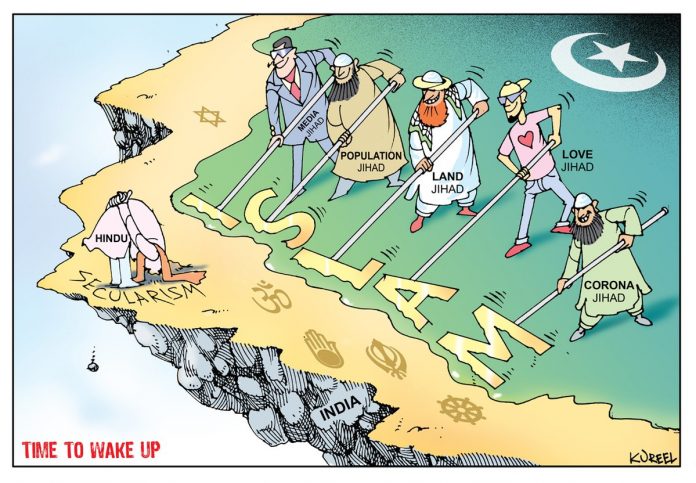By Salma Shah, TwoCircles.net
The rise of anti-Muslim hatred across the globe is the ramification of the negative stereotypical depiction of the religion of Islam by the media. The rise of Islamophobia is the outcome of the negative portrayal of Islam by the media and its detrimental effects are borne by the several innocent Muslims across the globe including India.
Media plays an important role in disseminating information and news. However, when the media engage in misrepresenting a community specifically Muslims, people form a negative picture of the religion of Islam and hence start generalizing the religion in a negative way.
There is a spurt in Islamophobia in the country in recent years. All thanks to the media. This spurt in Islamophobia is the consequence of portraying the religion of Islam in a negative way. The lynching of several Muslims can be attributed to rising Islamophobia. Even during the pandemic, Muslims are not spared — Nizamuddin Markaz Tablighi Jamaat fiasco had a detrimental effect on the Muslims of India and they are still bearing the brunt. Muslims are reportedly denied treatment in most of the hospitals, while Muslim vegetable and the fruit vendors are economically boycotted.
Another stereotyping of Muslims is the generalization of the criminals even if they coincidentally happen to be Muslims – they are being labelled as “terrorists” instead of “criminals.” When any criminal activity is carried out by non-Muslims, they are labelled as “criminals.” At the same time, if the criminals happen to be Muslims, they are labelled as “terrorists.” Criminals are criminals no matter which religion he or she belongs to. Why such prejudice against the Muslims?
Various media platforms such as the television news channels, electronic media, social media, entertainment, and media industry do not leave any stones unturned in stereotyping the Muslims. Take a look at how different media platforms influence the minds of people.
Television News Channels
The television news channels are apparently the most biased amongst all the media platforms. Giving a communal colour (Muslim picture) to any incidents that occur in the country has given them notoriety, which perhaps they enjoy. They were quick in coining the term, ‘Corona Jamaat’ for the Nizamuddin Markaz Tablighi Jamaatis. One news anchor even made a Jihad flowchart, and it was aired on his news channel in March this year.
If any rape or murder occurs in the country, the foremost thing the TV media looks at is to see is if the perpetrators are Muslims. If not, the TV media tries to fabricate the incident and try to give a Muslim angle. The rape of a doctor in Telangana in November last is yet another incident where they tried to give a Muslim angle because the one amongst the criminals was a Muslim.
Incidentally, the anti-Muslim hatred has become crucial and primary to the right-wing group and hence, the aftermath of it is the negative depiction of Muslims in political campaigns.
Entertainment and Media industry
Bollywood and Television industries play a major role in stereotyping Muslims as well. There are several such movies and tele-serials where Muslims are generalized and portrayed as living in the ghettos, having several siblings, and so on.
Ayushman Khurrana’s recent movie, “Dream Girl” is one such movie where Muslims are stereotyped though it was done to generate a good laugh. Not going in detail, just mentioning some examples here – “Muslims adding green to everything”, “Clean Mathura ko Green Bana Diya,” “Muslims having long names”, “Dying the hair red with Mehndi (Henna).”
In addition, actors playing the character of Muslims are often depicted as wearing Surma or black kohl in their eyes, black mark on their foreheads, wearing amulets on their necks etc. There are several such movies in Bollywood and Dawat-e-Ishq is one amongst them.
Social Media
Social media plays a significant role in forming a perspective of the stereotyping of Muslims. The wide circulation of the false narratives and the fake news contributed to anti-Muslim hatred. The WhatsApp forwards and Facebook posts have increased the hatred against India’s Muslims.
Not to forget Nazma Appi aka Salonyy, an Instagrammer who shot to fame during the implementation of CAA (Citizenship Amendment Act). Her short videos portraying a Muslim woman character, “Nazma Appi” garnered a lot of attention. In my view, this attempt by Salonny is stereotyping of Muslim women as being uneducated and having several children. Not that the country is short of educated Muslim women, the way it is being portrayed gives a general overview that the Muslim women are illiterate and have several children.
Indian Muslim women have been actively taking part in several fields like medicine, teaching, journalism, business, sports, research scholars, social activities to name a few. Just picking up a random character of a less wealthy and an uneducated Muslim household, generalizing them to generate laugh to rack in the moolah or garner the audience needs to be stopped. It is not humorous in any way but rather misrepresents the Indian Muslim women.
Such negative stereotyping of Muslims has impacted the lives of Muslims immensely. Muslims are being bullied in the office, face difficulties in getting accommodation and this condescending behaviour towards Muslims has its psychological implication, which needs to be highlighted.

